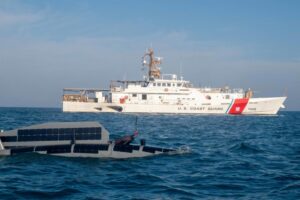HII [HII] and Ocean Aero announced the start of a strategic agreement that seeks to advance capabilities of both companies’ unmanned maritime platforms and autonomous software solutions, respectively.
Following the finalization of the agreement in February, the companies said they have begun multiple, simultaneous efforts “to enhance the operational reach and duration of the platforms, collaborative autonomy behaviors, shared sensor fusion and perception capabilities, and accelerated seabed-to-shore data transmission methods.”
Notably, HII spokesman Greg McCarthy told Defense Daily the companies plan to demonstrate combined capabilities at the International Maritime Exercise (IMX) U.S. 5th Fleet region event, which runs from Feb. 26 to March 16 (Defense Daily, Feb. 27).
McCarthy said the partners are specifically exploring three areas of collaboration including an Ocean Aero Triton autonomous underwater vehicles (AUV) towing an HII REMUS unmanned undersea vehicle (UUV) into an operational area and releasing the UUV to conduct its mission without human intervention; a wireless REMUS-to-Triton data file transfer where it is transferred to another node via BLOS pathways; and integration of HII’s Odyssey autonomy suite onto the Triton platform.
This means the companies’ goal is to develop a combined AUSV-UUV solution that combines the HII Odyssey autonomy software on the Triton AUSV to deploy a REMUS UUV and collect data from the REMUS.
HII launched the Odyssey suite of autonomy solutions in April, claiming it will help make any kind of vehicle a robotic system (Defense Daily, April 13, 2022).
“By combining HII’s UUVs and Autonomy with Ocean Aero’s AUSV, we will present an integrated multi-domain solution to Navy and Allied partners,” McCarthy said.

The companies said they are both currently involved in various unmanned maritime systems exercises around the world, like IMX 23. They highlighted Ocean Aero’s recent participation in the U.S. 5th Fleet Digital Horizon maritime domain awareness exercise in the Persian Gulf, while HII’s REMUS MK18 Mod 1 and Mod 2 vehicles have been deployed to the region since 2013.
Digital Horizon featured 15 unmanned systems from 17 industry partners, including Ocean Aero’s Triton autonomous underwater and surface vehicle, in an event led by the fleet’s Task Force 59. The task force is focused on speeding up integration of unmanned technologies and artificial intelligence. The event ended in December (Defense Daily, Dec. 15).
In Digital Horizon, the Navy worked with industry on phased evolutions both ashore and at sea to advance efforts that will bolster regional maritime awareness.
Previously, Ocean Aero’s Triton participated in the Navy’s Unmanned Integrated Battle Problem led by U.S. Pacific Fleet in 2021 (Defense Daily, April 20, 2021).
McCarthy said integration events started at Ocean Aero facilities earlier this year and the companies are evaluating further opportunities to demonstrate their capabilities.
![Graphic model of the HII Mission Technologies' REMUS 620 medium-class unmanned undersea vehicle (UUV). (Image: HII]](https://www.defensedaily.com/wp-content/uploads/2022/11/hii-remus-620-scaled-e1667585913538-300x169.jpg)
“We are pleased to partner with Ocean Aero to further expand the operational capabilities of the U.S. Armed Forces, partner nations and other maritime-focused commercial institutions. We are excited to combine the best of our individual products to deliver an exceptional suite of solutions to our customers,” Duane Fotheringham, president of the Unmanned Systems business group at HII’s Mission Technologies division, said in a statement.
Likewise, Ocean Aero CEO Kevin Decker agreed on the timing of the partnership.
“This is the perfect time for us to partner with HII. With rising maritime challenges increasing worldwide, we need new capabilities to meet them. Incorporating our two firms’ autonomous vehicle value propositions will unlock new tools for our customers at home and abroad,” Decker said.
In November, HII unveiled its newest medium-class unmanned undersea vehicle (UUV), the REMUS 620, improving upon the REMUS 600 12.75 inch diameter UUV (Defense Daily, Nov. 7, 2022).